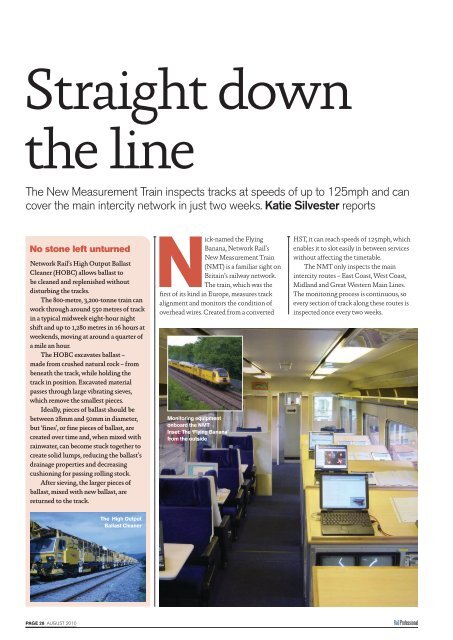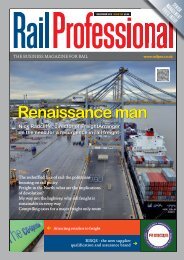View as PDF - Rail Professional
View as PDF - Rail Professional
View as PDF - Rail Professional
Create successful ePaper yourself
Turn your PDF publications into a flip-book with our unique Google optimized e-Paper software.
Straight down<br />
the line<br />
The New Me<strong>as</strong>urement Train inspects tracks at speeds of up to 125mph and can<br />
cover the main intercity network in just two weeks. Katie Silvester reports<br />
No stone left unturned<br />
Network <strong>Rail</strong>’s High Output Ball<strong>as</strong>t<br />
Cleaner (HOBC) allows ball<strong>as</strong>t to<br />
be cleaned and replenished without<br />
disturbing the tracks.<br />
The 800-metre, 3,200-tonne train can<br />
work through around 550 metres of track<br />
in a typical midweek eight-hour night<br />
shift and up to 1,280 metres in 16 hours at<br />
weekends, moving at around a quarter of<br />
a mile an hour.<br />
The HOBC excavates ball<strong>as</strong>t –<br />
made from crushed natural rock – from<br />
beneath the track, while holding the<br />
track in position. Excavated material<br />
p<strong>as</strong>ses through large vibrating sieves,<br />
which remove the smallest pieces.<br />
Ideally, pieces of ball<strong>as</strong>t should be<br />
between 28mm and 50mm in diameter,<br />
but ‘fines’, or fine pieces of ball<strong>as</strong>t, are<br />
created over time and, when mixed with<br />
rainwater, can become stuck together to<br />
create solid lumps, reducing the ball<strong>as</strong>t’s<br />
drainage properties and decre<strong>as</strong>ing<br />
cushioning for p<strong>as</strong>sing rolling stock.<br />
After sieving, the larger pieces of<br />
ball<strong>as</strong>t, mixed with new ball<strong>as</strong>t, are<br />
returned to the track.<br />
Nick-named the Flying<br />
Banana, Network <strong>Rail</strong>’s<br />
New Me<strong>as</strong>urement Train<br />
(NMT) is a familiar sight on<br />
Britain’s railway network.<br />
The train, which w<strong>as</strong> the<br />
first of its kind in Europe, me<strong>as</strong>ures track<br />
alignment and monitors the condition of<br />
overhead wires. Created from a converted<br />
Monitoring equipment<br />
onboard the NMT<br />
Inset: The ‘Flying Banana’<br />
from the outside<br />
HST, it can reach speeds of 125mph, which<br />
enables it to slot e<strong>as</strong>ily in between services<br />
without affecting the timetable.<br />
The NMT only inspects the main<br />
intercity routes – E<strong>as</strong>t Co<strong>as</strong>t, West Co<strong>as</strong>t,<br />
Midland and Great Western Main Lines.<br />
The monitoring process is continuous, so<br />
every section of track along these routes is<br />
inspected once every two weeks.<br />
The High Output<br />
Ball<strong>as</strong>t Cleaner<br />
PAGE 28 AUGUST 2010
















